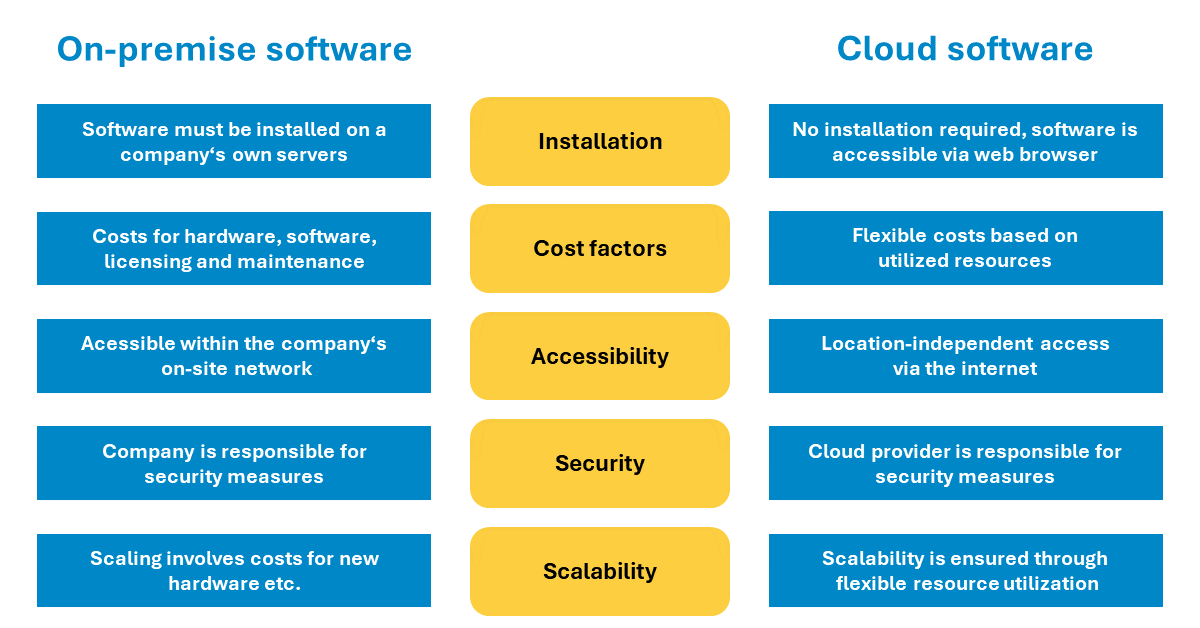Which solution is the right one?
Cloud vs. On-premise
in Production
In a traditional on-premise approach, software is installed and run on a company’s local servers. On the other hand, there are cloud solutions where software is made available via the Internet by third-party providers. The cloud approach offers key advantages in many sectors and manufacturing is no exception. In this article we compare cloud and on-premise solutions with a focus on production environments.
Cloud vs. on-premise – The main differences at a glance

What does „on-premise“ mean?
„On-premise“ is the classic approach to using software, meaning a company manages all the needed resources itself. Software is installed and operated on the company’s own (local) servers.
This requires hardware, server rooms, security measures and redundancies. In return, the company retains full control over its software and data. This also means that with an on-premise approach, maintenance and updates must be regularly performed by the company’s IT staff.
Advantages of on-premise software:
On-premise approaches offer a high degree of control, as a company has the entire installation, usage and management process in its own hands.
- Greater control over own data
- More flexible customization
- Offline access
Greater control over own data:
With a classic on-premise approach, a company manages its hardware and software itself, including all maintenance and security updates. All data remains with the company and is often only accessible within a local network, while the company bears full responsibility for data protection and security. Sometimes, a setup like this is required to comply with legal requirements when handling sensitive (personal) data.
More flexible customization:
With an on-premise approach, companies can configure and adapt their software and the underlying hardware systems themselves at any time to meet individual requirements. However, it should be noted that such adaptations (e.g. acquisition and integration of new hardware) are often associated with high costs and/or time expenditure.
Offline access:
In contrast to cloud services, the use of on-premise software does not require a constant internet connection. Applications are accessible even if the internet fails and the stability of the internet connection has less impact on the performance of systems.
Disadvantages of on-premise software:
The main disadvantages of the on-premise approach include the increased time and costs required to install, operate and maintain the software. Some further limitations are discussed below.
- High acquisition costs
- IT costs for maintenance and security
- Operating costs
- Limited scalability
- Data recovery and redundancy
- Limited accessibility
- Outdated technology
High acquisition costs:
Setting up an on-premise solution requires comparatively high (initial) costs. Setting up the necessary infrastructure requires the availability of server rooms, the purchase of hardware, the acquisition of licenses and the installation of security and monitoring systems.
IT costs for maintenance and security:
With an on-premise approach, the company is responsible for all maintenance, updates and security measures. These tasks must be carried out by competent IT staff.
Operating costs:
In addition to costs for IT tasks and personnel, on-premise solutions incur additional ongoing costs. These include costs such as energy consumption and cooling.
Limited scalability:
Scaling on-premise solutions can be complex and costly. If a company grows and wants to expand its existing capacity, additional hardware must be purchased, integrated and configured. In comparison, many cloud services allow for easier and often immediate scaling.
Data recovery and redundancy:
Building redundancy and backup structures can be challenging and expensive with an on-premise solution, especially for smaller organizations. While large cloud providers offer geographic redundancy through distributed data centers and automated backups, companies that rely on on-premise software must implement their own safeguards.
Limited accessibility:
In many cases, on-premise software can only be accessed within a company’s network.
Outdated technology:
Many cloud services are regularly updated to include new technologies and features. With on-premise solutions, it is more common for companies to work with outdated technology, as upgrades and updates can be both costly and time-consuming.
Cloud computing as a modern alternative
Since its emergence in the early 2000s, cloud computing services have replaced traditional on-premise hosting in many places.
Cloud software is operated on the servers of a third-party provider and made available via the internet (also referred to as software-as-a-service). Companies that use cloud software do not have to install it themselves. Instead, they access it via web browser, thereby eliminating the cost of purchasing and maintaining their own server hardware.
Generally, the cloud provider is responsible for maintaining the software, including all functional and security updates.
A stable internet connection is required to use cloud services.
Advantages of cloud software:
When using cloud services, both hardware requirements and a large part of the administrative workload are outsourced to a third-party provider.
- No installation required
- Eliminating costs for own hardware
- Saving costs for license management
- Maintenance and security by the cloud provider
- Location-independent access
- Scalability
No installation required:
Cloud software does not require installation on the company’s servers. Instead, cloud access is set up via the web browser. This process can often be completed within minutes, also minimizing the effort required to test software.
Eliminating costs for own hardware:
Companies do not need to purchase their own server hardware and the associated hardware and software components. Organizations who rely entirely on cloud software do not need their own server rooms. There is also no need to set up redundancies.
Saving costs for license management:
The management of server and software licenses is also a relevant cost item for many manufacturers. This is no longer necessary with cloud services which usually only require a subscription or payment for the resources used.
Maintenance and security by the cloud provider:
With on-premise solutions, the company itself is responsible for maintenance and security. Cloud software on the other hand is often fully maintained by the cloud provider. This includes not only functional development and troubleshooting, but also security measures and updates. As a result, a considerable amount of IT administration is no longer required, which reduces personnel costs and relieves the burden on the IT department.
Location-independent access:
Cloud services can be accessed from anywhere via the internet, offering a high degree of flexibility for remote work and process monitoring.
Scalability:
One of the most important advantages of many cloud offerings is the ability to scale up or down at any time. If a company wants to expand its capacities, new resources can be easily added or the subscription model adjusted. As a result, the investment risk is significantly lower than when setting up a corresponding on-premise infrastructure, which cannot be scaled back again when capacity is underutilized.
Disadvantages of cloud software:
A (stable) internet connection is a prerequisite for using cloud services. The handling of sensitive data by a cloud provider can also pose a challenge in certain scenarios.
- Internet connection
- Data management by third-party providers
- Limited customization options
- Regulatory requirements
Internet connection:
The use of cloud software requires a stable internet connection. A poor connection can impair the usability of applications, especially when large amounts of data are being transferred.
Data management by third-party providers:
In classic cloud computing, a company’s data is managed by a third-party cloud provider. Many cloud providers implement extensive security measures to ensure data security and data protection. Even then, a high level of trust is required.
Limited customization options:
Standardized cloud services typically do not offer the same depth of customization and control that is possible with on-premise solutions. This can be a limitation for companies that require specific customization.
Regulatory requirements:
In some industries, the use of certain cloud services may not be compatible with regulatory requirements – especially when it comes to managing sensitive data.
Comparison
Cloud or on-premise – Which solution is the right one?
Cloud-based SaaS applications and services have found their way into a wide range of industries. Companies of different sizes are outsourcing the management of hardware and software to cloud providers in order to focus more on their own core business. The scalability of cloud resources and rather uncomplicated access are also among the most common reasons why companies opt for the cloud.
On the provider side, there is plenty of choice: A constantly growing number of cloud platforms and cloud applications for a wide range of industries and use cases increases the chance that companies will find a suitable solution.
Nevertheless, traditional on-premise hosting of software is not going away: Especially in cases where certain legal or functional requirements need to be met, it is still necessary to set up an in-house infrastructure.
Cloud computing in production
Even though cloud services are already in use in many areas of industrial production, there is still a lot of untapped potential for manufacturers.
Many production sites generate large amounts of isolated data. If this production data is transferred to the cloud, it can not only be used for company-wide analyses, but also directly influence production control. If there is a secure connection between local production systems and the cloud, processes can be monitored, managed and optimized from a central platform in real-time.
With manubes, we have developed a specialized cloud platform for production that builds on a powerful cloud infrastructure and puts security, performance and scalability at the forefront.
manubes offers innovative tools for recording, structuring and real-time visualization of production data as well as for the automation and monitoring of production processes.

Cloud-based production management with manubes
manubes is a cloud platform specifically tailored to the needs of manufacturers. With manubes, companies of any size are able to rapidly develop future-proof solutions in areas such as production planning, process control and asset monitoring.
